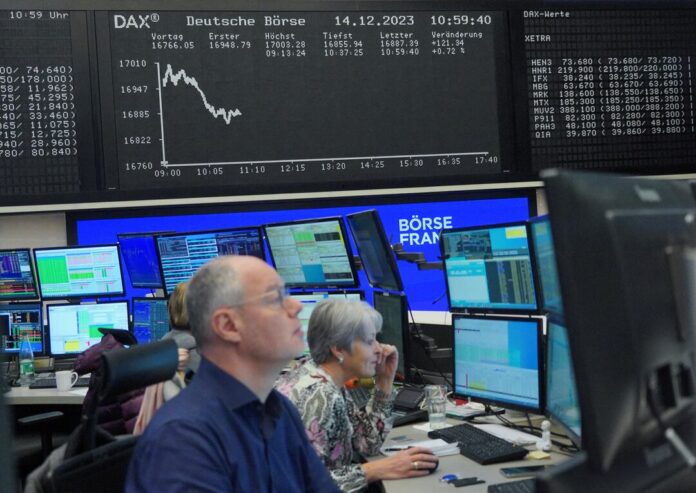European Shares Fall Amid Nvidia and ASML Concerns: European markets slid lower on Wednesday, ending a brief two-day winning streak. The pan-European Stoxx 600 index declined 0.8% by mid-morning in London, reversing Monday’s gains of 2.69% and Tuesday’s gains of 1.63%. Sentiment damped throughout the region as investors reacted to a combination of corporate earnings, inflation reports, and fresh tariff uncertainty. Germany’s DAX and France’s CAC 40 each lost about 1%, while the U.K.’s FTSE 100 declined 0.44%.
ASML Misses Bookings Projections, Shares Plummet
The biggest hit was from the tech industry. ASML shares plummeted 4.6% after the Dutch chip equipment company fell short of market projections for net bookings during the first quarter. ASML posted bookings of €3.94 billion, which was below the projected €4.89 billion. The company attributed continuing uncertainty over U.S. trade policy as a major headwind. Peer ASM International also fell 3.5% in sympathy.
Analysts pointed out that it’s still “too early to tell” just how much new tariffs would hurt ASML’s business. Yet investors were not taking any chances, and the decline of the stock pulled wider technology indices lower in Europe.
Nvidia’s $5.5 Billion Blow Adds to Pressure on Global Chip Stocks
The downward momentum spilled over into Europe. U.S. chip behemoth Nvidia announced a $5.5 billion quarterly charge related to export restrictions on its H20 processors to China and other countries. The news caused Nvidia shares to plummet more than 6% in after-hours trading. That shockwave spilled over into Asia, where leading semiconductor stocks such as Advantest, Softbank, and TSMC also traded lower.
With chipmakers already on the ropes from supply chain worries and regulatory scrutiny, the Nvidia breakthrough extended worldwide tech sell-offs and questioned the strength of future earnings.
Also read: Hong Kong Postal Service Suspends US Deliveries Amid Trade Tensions
Tariff Uncertainty Casts Long Shadow Over Sentiment
Markets have been in a tizzy over U.S. President Donald Trump’s shifting tariff policy. The threat of additional trade barriers is making international investment choices more difficult, particularly in sensitive fields such as semiconductors. Investors are concerned about the ripple impact on production, supply chains, and global demand.
The uncertainty is also at the back of corporate expectations. As seen in ASML’s and Heineken’s reports, companies are bracing themselves for a tough backdrop characterized by macroeconomic uncertainty, unstable trade policies, and inflation.
Mixed Economic Signals: UK Inflation Cools, China Surprises
Even as markets fell, there was some good news in economic data. Inflation in the U.K. slowed more than anticipated, down to 2.6% in March from a predicted 2.7%. The statistics, published by the Office for National Statistics, may help alleviate pressure on the Bank of England to increase interest rates.
Meanwhile, China’s economy grew 5.4% in the first quarter, beating analysts’ expectations. Retail sales and industrial production figures were also stronger than forecast. However, despite the upbeat data, major banks remain cautious, citing the potential drag from escalating trade tensions with the U.S.
Heineken Revenue Beats but Beer Sales Decline
On the business side, Dutch brewer Heineken said first-quarter revenue was €7.78 billion—better than forecast—but recorded a 2.1% decline in beer sales. Organic net revenue excluding exceptions increased 0.9%, bucking expectations of a fall. However, the firm recognized macroeconomic uncertainty and tariff-related uncertainty that may put pressure on consumer expenditure in the next few months.
CEO Dolf van den Brink noted that premium brand beers experienced small growth, up 1.8%, as overall consumption softened. Heineken confirmed its guidance for operating profit growth next year between 4% and 8%.
Gold Hits Record High as Investors Flee to Safety
As stocks came under stress and anxiety about increased trade tension grew, investors took refuge in gold. Spot prices spiked to an all-time $3,261.62 per ounce. ANZ analysts said they see institutional appetite for gold increasing as risk in the equity market intensifies, with prices potentially rising to $3,400.








